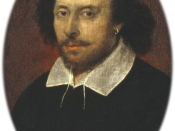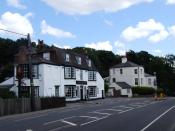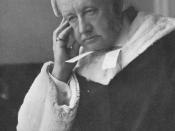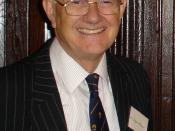From the opening lines of the novel, where rumour spreads itself causing confusion and uncertainty, the tone of disorder is set. The play can be described as having a frame of disorder, which is eventually unraveled and organized by Prince Henry. The absence of a powerful king figure has enabled civil war to flourish: The disorder in the sick King Henry IVÃÂs mind is paralleled by disorder in his body; this is mirrored in the confused and leaderless country, where corruption and political expediency rather than noble cause prevail. Disease and disorder are recurring themes in this play; society seems to be plagued ÃÂA pox of this goutÃÂ.
Sir John FalstaffÃÂs job is seemingly to cause disorder ÃÂ he breaks the law and lacks morals. He appears to spend the majority of time either in the Tavern, or a ÃÂhouse of ill reputeÃÂ; both have strong connotations to disorder and sordidness.
The witty but torpid Sir John coasts through life freeloading off people who earn a hard living, and has the ability to talk himself out of almost any situation with his verbal mastery. He can be seen at many times verbally jousting with the Lord Chief Justice, who acts as a voice of reason, and arguably order, in this play. The Lord Chief Justice is presented as an anti-Falstaff and is the only one who can control his rants. He serves as a force of order in this play, and can successfully neutralize any situation, calming and fairly resolving situations in his path.
The two characters represent the choice that faces Prince Hal: to side with Falstaff with his bawdy ways and loose living, which the Prince once enjoyed or the Lord Chief Justice who is a man of principles and seeks to impose the letter of the law and order to the Country. This is one of the central themes running throughout the play. The exchanges throughout the play between Falstaff and the Lord Chief Justice are presented by Shakespeare as a power struggle; order versus disorder, the firm but fair Judge versus the lovable rogue. The audience can see that there can only be one winner in the end, as the play progresses, the balance of power shifts from Sir John to the Lord Chief Justice, mirroring the shift in the loyalty of young Bolingbroke in the same direction. In the end, Bolingbroke becomes Henry V, rejects Falstaff and embraces the Lord Chief Justice, conveying the sense that he has grown as a character and will restore order to the turmoil that was England prior to his rule.
Throughout most of the play, the audience sees no clear distinction between good and bad. This is cleverly executed by Shakespeare to reinforce the air of confusion and disorder. The audienceÃÂs loyalty is often split between the two sides of the various conflicts. Henry IV was previously a rebel, who usurped the throne of Richard II subsequent to his banishment; no side is presented as wholly in the ÃÂrightÃÂ. However, the Rebels have no clear cause, and it seems they are fighting for personal gain. Furthermore, all leaders seem to be guided by political necessity or expediency rather than moral cause. This does not generate sympathy. The Audience is often unsure whether to be critical or sympathetic, for example the rejection of Falstaff by Prince Henry. While the audience know this is probably the right thing to do, as it is serving the path of justice, there is a strong sense of sympathy for Sir John, who has served as a great friend of Henry, who appears to have used Sir John; being friends when it suited him, but quickly terminating the friendship, and punishing Falstaff a moment later. This enforces the tendency for friends to betray and use each other; a nasty trick is played on Falstaff, and Henry seems arrogant and superior when talking to Poins.
There is a sense of disorder surrounding NorthumberlandÃÂs character. ÃÂLet heaven kiss earth! Now let not Natures hand keep the wild flood confined.ÃÂ He wants to ÃÂLet order dieÃÂ and allow the country to descend into a state of chaos and mayhem. Whilst NorthumberlandÃÂs son rebelled against the government for what he believed was a just cause, the dishonourable Earl wants to attack for personal reasons, rather than a noble cause. He is dishonourable and causes disorder, much like Falstaff. Northumberland also causes disorder on his own side when he pulls out of the rebellion, and effectively dooms his side to failure.
Fang and Snare are two characters used to personify the lack of power present in the law; they provide a humorous scene, containing serious undertones regarding the state of unrest that the country lies in. They hopelessly try to apprehend Falstaff for his unpaid debt, and are thrown off course by Sir JohnÃÂs potent wit. Debt is another theme that reoccurs in this play, and one also associated with disorder.
In conclusion I would agree that the main theme in the play is disorder. The main story is the ordering of a crushed state, by crowning a new King who is powerful. Disorder is used by Shakespeare both as a tool of comedy, and to create salient points.
Bibliography Wikipedia - article Henry IV Part IIMozilla FirefoxMac OS XMicrosoft WordHenry IV Part II





